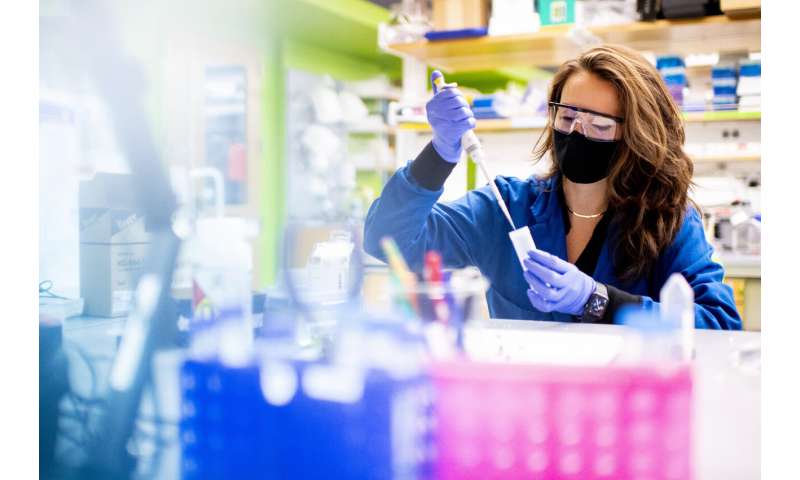
These days, novel diseases such as COVID-19 are pushing scientists to work real hard and real fast to find treatments and cures for patients.
But there are also many other types of old foes that live within us—diseases that have been part of our lives for such a long time that we can easily forget how much (or little) we know about them and their causes.
Asthma is one of these diseases, and it affects millions and millions of people around the world.
Scientists think that asthma results from the behavior of unhealthy cells within the human airway. But now, researchers at Northeastern have found that the way those cells trigger asthmatic attacks isn’t only a result of how they communicate with one another.
Rather, that behavior is also a result of the interactions of airway cells with a mesh of important proteins and molecules known as the extracellular matrix, which isn’t part of the cells but serves as a structural and biochemical support for them.
The new findings show how even healthy human airway cells in contact with each other can respond to a stimulus in a similar way as the unhealthy cells from an asthmatic person—that is, if they are also in contact with an unhealthy extracellular matrix.
“We have known for decades that there are pathological changes to the extracellular matrix,” says Harikrishnan Parameswaran, an assistant professor of bioengineering who led the study. “But its functional consequence in asthma was not known.”
During an asthma attack, the cells in someone’s airway react to different substances and constrict, or stiffen. That swelling affects the capability of the airway to supply air to the lungs.
Because that reaction occurs when those cells receive a very small dose of the substance that causes such physiological response, conventional research to tackle asthma has largely focused on it as a disease of those particular cells.
The new findings, however, show that asthma is not entirely a disease of those cells. Instead, Parameswaran says, it could be a result from a situation in which healthy cells find themselves in a bad extracellular environment.
That’s because as the disease progresses over time, the properties of the material outside the cells, as well as its influence on them, can also change.
“This gives you a mechanism by which this extracellular matrix remodeling actually impacts constriction,” Parameswaran says.
Research into better treatments for asthmatic people normally focuses on the pathology of the cells, and leaves the matrix outside of the equation.
Scientists have generally focused on the collective behavior of the kinds of cells that line the airway, known as smooth muscle cells. These types of cells coordinate different kinds of involuntary stretching and squeezing in various parts of our insides, including the gut, uterus, and other hollow organs.
Many of our cells use small openings within them, known as gap junctions, for intracellular communication. Those openings work like tunnels of a highway system that create communication networks. Through those gaps, cells can talk to each other, and send the various types of signaling molecules that trigger the physiological machinations that orchestrate simple and complex bodily functions.
Cells are known to use calcium waves extensively to communicate with one another through gap junctions. But even after disassembling those gaps, Parameswaran’s team didn’t see a change in the way calcium propagated along the muscle.
On those extracellular layers, cells responded differently to the stimulus when they were together than when they were apart. And their mechanical communication responded as if they had received a very strong dose of histamine, even though they did not.
That observation told Parameswaran’s team that the airway cells do not rely on gap junctions. Instead, he says, the stiffening of the extracellular matrix appears to connect them and create the collective action that triggers the stiffening in response.
Parameswaran says he believes asthma persists because of the molecular changes within the matrix that scientists haven’t targeted extensively.
That’s why, he says, in the specific case of the human airway, the discovery means that researchers might need to start developing therapies that can target stiffening of the extracellular matrix in the airway to treat asthma.
“There is no cure for asthma,” Parameswaran says. “Because we have specific evidence that pathological stiffening in the extracellular environment is sufficient to cause hyper-constriction, it is imperative now to see if we can target matrix stiffening as a therapy.”
Those findings fit within an active area of research in biophysics that explores how cells use more than just gap junctions to trigger collective actions within the body. The discovery of how they coordinate collective behavior in the airway is something that scientists have previously not been able to see, says Erin Cram, a professor of biology who co-led the new study.
“These cells respond differently as a collective than they do as individuals,” Cram says. “It’s kind of like a mob that responds differently to a stimulus than four or five individuals spread out over a field.”
In the long run, unveiling ways of intercellular communication like that could also help other scientists understand how smooth muscles in the airway and other organs interact with the rest of the biochemistry of the body, says Cram, whose lab studies the reproductive system of Caenorhabditis elegans, a microscopic worm with cells that behave in similar ways to human smooth muscle cells.
Source: Read Full Article
